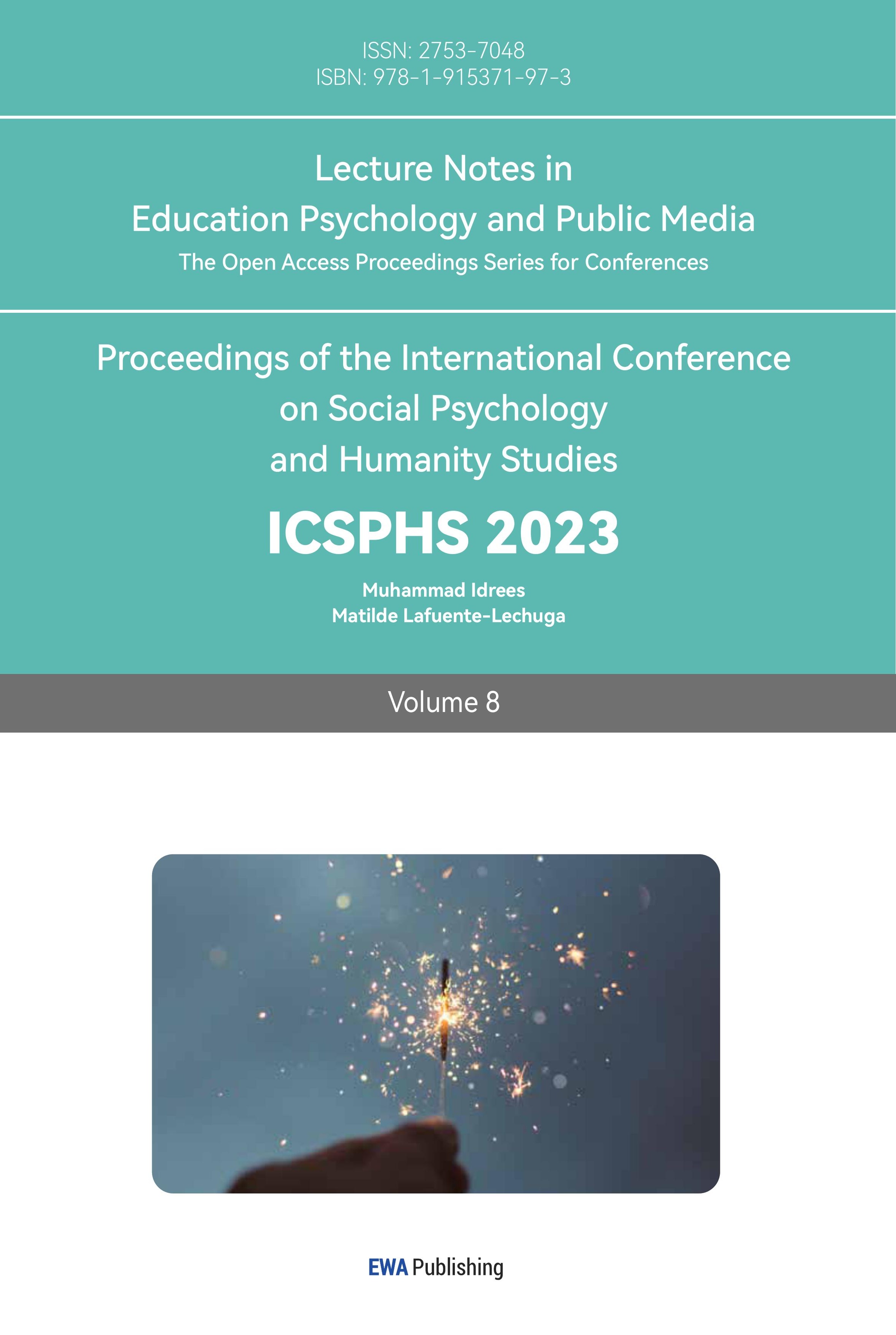References
[1]. Andersson, G. (2005). A study on policies and practices in selected countries that encourage childbirth: the case of Sweden. Contribution to the Consultancy Study on Population Related Matters–A Study on Policies and Practices in Selected Countries that Encourage Childbirth, for the Government of Hong Kong Special Administrative Region. Max Planck Institute for Demographic Research Working Paper, 5.
[2]. Zoch, G., & Schober, P. S. (2018). Public Child‐Care Expansion and Changing Gender Ideologies of Parents in Germany. Journal of Marriage and Family, 80(4), 1020–1039. https://doi.org/10.1111/jomf.12486
[3]. Fang, M. Y., & Wang, T. (2006). Challenge facing China’s economic growth in its aging but not an affluent era. China & World Economy, 14(5), 20–31. doi:10.1111/j.1749-124X.2006. 00035.x
[4]. Gong, W., Xu, D. (Roman), & Caine, E. D. (2016). Challenges arising from China’s two-child policy. The Lancet, 387(10025), 1274. https://doi.org/10.1016/s0140-6736(16)30020-4
[5]. Wang, F., Zhao, L., & Zhao, Z. (2016). China’s family planning policies and their labor market consequences. Journal of Population Economics, 30(1), 31–68. https://doi.org/10.1007/s00148-016-0613-0
[6]. Shuming, Z. (2014, December 9). Management Practices in High-Tech Environments and Enterprises in the People's Republic of China. https://doi.org/10.2753/CES1097-, 1475410302. https://www.tandfonline.com/doi/abs/10.2753/CES1097-1475410302
[7]. Hong, J. (2016). Do government grants promote innovation efficiency in China’s? high-tech industries? Technovation, 57-58, 4-13. https://www.sciencedirect.com/science/article/pii/S0166497216301018
[8]. Peterson, E. W. F. (2017). The Role of Population in Economic Growth. SAGE Open, 7(4), 215824401773609. https://doi.org/10.1177/2158244017736094, Menz, G. (2002). Patterns in EU labor immigration policy: National initiatives and European responses. Journal of Ethnic and Migration Studies, 28(4), 723–742. https://doi.org/10.1080/1369183021000032281
[9]. Riley, N. (2004). China’s Population: New Trends and Challenges, BULLETIN A publication of the Population Reference Bureau Population. https://case.edu/affil/tibet/tibetanSociety/documents/Riley2004.pdf
[10]. Language laboratory. (2021). National Bureau of Statistics: The birth rate fell. below 1% for the first time in 2020. https://www.sohu.com/a/502679908_121118946
[11]. Weiqiang, L. (2021). “Qipu”data revealed: China's floating population has reached 376 million. "A family of three" has been subverted for the first time. Northeast China has the lowest sex ratio. https://huhehaote.house.ifeng.com/news/2021_05_12-54166923_0.shtml
[12]. Jinqian, M. (2019). The education level of the elderly in primary schools and below in China exceeds 70%, which affects their quality of life. https://baijiahao.baidu.com/s?id=1654421668390192194&wfr=spider&for=pc
Cite this article
Huang,X. (2023). Research on the Solutions to the Chinese Labor Shortage Caused by Population Aging. Lecture Notes in Education Psychology and Public Media,8,129-132.
Data availability
The datasets used and/or analyzed during the current study will be available from the authors upon reasonable request.
Disclaimer/Publisher's Note
The statements, opinions and data contained in all publications are solely those of the individual author(s) and contributor(s) and not of EWA Publishing and/or the editor(s). EWA Publishing and/or the editor(s) disclaim responsibility for any injury to people or property resulting from any ideas, methods, instructions or products referred to in the content.
About volume
Volume title: Proceedings of the International Conference on Social Psychology and Humanity Studies
© 2024 by the author(s). Licensee EWA Publishing, Oxford, UK. This article is an open access article distributed under the terms and
conditions of the Creative Commons Attribution (CC BY) license. Authors who
publish this series agree to the following terms:
1. Authors retain copyright and grant the series right of first publication with the work simultaneously licensed under a Creative Commons
Attribution License that allows others to share the work with an acknowledgment of the work's authorship and initial publication in this
series.
2. Authors are able to enter into separate, additional contractual arrangements for the non-exclusive distribution of the series's published
version of the work (e.g., post it to an institutional repository or publish it in a book), with an acknowledgment of its initial
publication in this series.
3. Authors are permitted and encouraged to post their work online (e.g., in institutional repositories or on their website) prior to and
during the submission process, as it can lead to productive exchanges, as well as earlier and greater citation of published work (See
Open access policy for details).
References
[1]. Andersson, G. (2005). A study on policies and practices in selected countries that encourage childbirth: the case of Sweden. Contribution to the Consultancy Study on Population Related Matters–A Study on Policies and Practices in Selected Countries that Encourage Childbirth, for the Government of Hong Kong Special Administrative Region. Max Planck Institute for Demographic Research Working Paper, 5.
[2]. Zoch, G., & Schober, P. S. (2018). Public Child‐Care Expansion and Changing Gender Ideologies of Parents in Germany. Journal of Marriage and Family, 80(4), 1020–1039. https://doi.org/10.1111/jomf.12486
[3]. Fang, M. Y., & Wang, T. (2006). Challenge facing China’s economic growth in its aging but not an affluent era. China & World Economy, 14(5), 20–31. doi:10.1111/j.1749-124X.2006. 00035.x
[4]. Gong, W., Xu, D. (Roman), & Caine, E. D. (2016). Challenges arising from China’s two-child policy. The Lancet, 387(10025), 1274. https://doi.org/10.1016/s0140-6736(16)30020-4
[5]. Wang, F., Zhao, L., & Zhao, Z. (2016). China’s family planning policies and their labor market consequences. Journal of Population Economics, 30(1), 31–68. https://doi.org/10.1007/s00148-016-0613-0
[6]. Shuming, Z. (2014, December 9). Management Practices in High-Tech Environments and Enterprises in the People's Republic of China. https://doi.org/10.2753/CES1097-, 1475410302. https://www.tandfonline.com/doi/abs/10.2753/CES1097-1475410302
[7]. Hong, J. (2016). Do government grants promote innovation efficiency in China’s? high-tech industries? Technovation, 57-58, 4-13. https://www.sciencedirect.com/science/article/pii/S0166497216301018
[8]. Peterson, E. W. F. (2017). The Role of Population in Economic Growth. SAGE Open, 7(4), 215824401773609. https://doi.org/10.1177/2158244017736094, Menz, G. (2002). Patterns in EU labor immigration policy: National initiatives and European responses. Journal of Ethnic and Migration Studies, 28(4), 723–742. https://doi.org/10.1080/1369183021000032281
[9]. Riley, N. (2004). China’s Population: New Trends and Challenges, BULLETIN A publication of the Population Reference Bureau Population. https://case.edu/affil/tibet/tibetanSociety/documents/Riley2004.pdf
[10]. Language laboratory. (2021). National Bureau of Statistics: The birth rate fell. below 1% for the first time in 2020. https://www.sohu.com/a/502679908_121118946
[11]. Weiqiang, L. (2021). “Qipu”data revealed: China's floating population has reached 376 million. "A family of three" has been subverted for the first time. Northeast China has the lowest sex ratio. https://huhehaote.house.ifeng.com/news/2021_05_12-54166923_0.shtml
[12]. Jinqian, M. (2019). The education level of the elderly in primary schools and below in China exceeds 70%, which affects their quality of life. https://baijiahao.baidu.com/s?id=1654421668390192194&wfr=spider&for=pc









